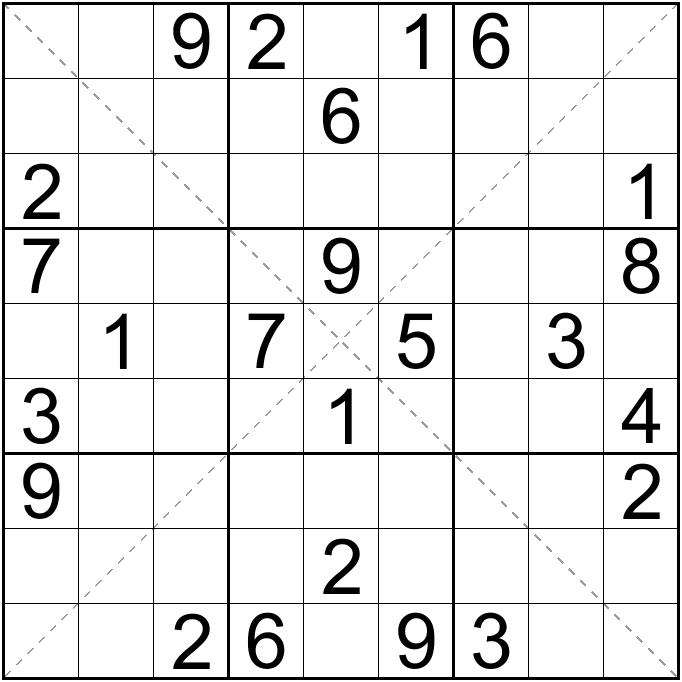Diagonal Sudoku is an intriguing twist on the classic Sudoku puzzle that adds an exciting layer of complexity. While traditional Sudoku requires players to fill a grid with numbers so that each row, column, and 3x3 subgrid contains all digits from 1 to 9, Diagonal Sudoku introduces additional rules. In this variation, each of the two main diagonals must also contain all digits from 1 to 9, making it a true test of logic and strategy.
This engaging puzzle has captivated enthusiasts around the globe and has become a popular choice for those seeking a challenge beyond the standard Sudoku format. Whether you are a seasoned player or a curious newcomer, mastering Diagonal Sudoku can enhance your problem-solving skills while providing endless hours of entertainment. In this article, we will delve into the rules, strategies, and tips for solving Diagonal Sudoku puzzles, as well as explore its growing popularity in the puzzle community.
As we journey through the fascinating world of Diagonal Sudoku, we will address common queries, examine effective solving strategies, and provide resources to help you improve your skills. So, gather your pencils and paper, and prepare to explore this exciting realm of numbers and logic!
What are the Rules of Diagonal Sudoku?
Understanding the rules of Diagonal Sudoku is essential for both beginners and experienced players. Here are the key rules you need to know:
- Each row must contain the digits 1 to 9 without repetition.
- Each column must also contain the digits 1 to 9 without repetition.
- Each of the nine 3x3 subgrids must contain the digits 1 to 9 without repetition.
- Additionally, the two main diagonals (from the top-left to bottom-right and from the top-right to bottom-left) must also contain the digits 1 to 9 without repetition.
How is Diagonal Sudoku Different from Traditional Sudoku?
The primary difference between Diagonal Sudoku and traditional Sudoku lies in the additional constraints imposed by the diagonals. While traditional Sudoku focuses solely on rows, columns, and subgrids, Diagonal Sudoku requires players to think in a more comprehensive manner. This added layer of complexity can make Diagonal Sudoku puzzles more challenging and engaging, appealing to players who are looking for a greater mental workout.
Why Should You Try Diagonal Sudoku?
Diagonal Sudoku offers numerous benefits that make it worth trying. Here are some reasons to give it a shot:
- Enhances logical reasoning and problem-solving skills.
- Provides a fresh twist on a classic puzzle.
- Can be enjoyed alone or with friends.
- Available in various difficulty levels to suit all players.
What Strategies Can Help You Solve Diagonal Sudoku?
To successfully tackle Diagonal Sudoku puzzles, consider employing the following strategies:
- Start with the Basics: Begin by filling in the easiest numbers based on the provided clues.
- Look for Duplicates: Check rows, columns, and diagonals for any duplicate numbers to eliminate possibilities.
- Use Pencil Marks: Write down possible numbers in empty cells to help visualize your options.
- Work on the Diagonals: Don’t forget to consider the diagonal constraints while solving.
Can You Find Diagonal Sudoku Puzzles Online?
Yes, numerous websites and apps offer a wide variety of Diagonal Sudoku puzzles for players of all skill levels. Many platforms provide options to select difficulty levels, making it easy to find the right challenge. Additionally, some websites offer tutorials and tips to help beginners understand the intricacies of the game.
What Tools Can Assist You in Solving Diagonal Sudoku?
Using the right tools can enhance your solving experience. Here are some helpful tools:
- Printable Sudoku grids for offline play.
- Sudoku solver apps that help you check your answers.
- Pencil and eraser for easy adjustments.
- Digital platforms that allow you to play online.
Is Diagonal Sudoku Suitable for All Ages?
Absolutely! Diagonal Sudoku can be enjoyed by people of all ages. It offers various difficulty levels, making it accessible for children, teenagers, and adults alike. The game promotes critical thinking and concentration, making it a wonderful activity for family game nights or solo practice.
Where Can You Find Resources to Improve Your Diagonal Sudoku Skills?
To enhance your Diagonal Sudoku skills, consider exploring the following resources:
- Online tutorials and instructional videos.
- Books dedicated to Sudoku strategies.
- Puzzle magazines that include Diagonal Sudoku challenges.
- Online forums and communities for puzzle enthusiasts.
In conclusion, Diagonal Sudoku is a captivating puzzle that offers a unique twist on the traditional game. With its additional rules and challenges, it not only entertains but also sharpens your cognitive abilities. Whether you are a beginner or an expert, diving into the world of Diagonal Sudoku can be both rewarding and fun. So why not give it a try and unlock the mysteries that lie within those diagonal lines?




